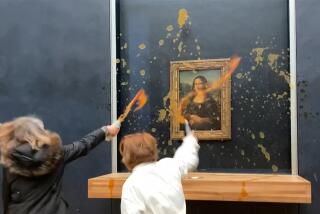Sculptor works to reshape the Iraqi art world
- Share via
Reporting from Baghdad — Sculptor Abdul Hameed is proud of how his art form holds a mirror up to society, from Iraq’s ancient civilization to its current times of pain and hope.
Sculpture “is one of the means which reflect the reality of life,” says the chief of the sculpture department at Baghdad’s Institute of Fine Arts. “We can’t cancel this art in our society. If we do so, we isolate ourselves from the world.”
Sometimes, however, reflecting reality can be a hardship.
During the Saddam Hussein years, only statues for — and of — Hussein were encouraged, Hameed remembers. Sculptors who didn’t join the dictator’s Baath Party were harassed. Many fled into exile, including Hameed.
One of the dictator’s many elaborate palaces featured a Hameed sculpture: a 26-foot-high bronze date palm in the form of the face and chest of a woman, her hair the fronds of the tree.
“The woman represents life, fertility and beauty,” explains Hameed, who says he faced pressure to make statues of Hussein and feared for his family’s safety.
But even if the Hussein era brought him pain, Hameed, 57, objects to moves by the Baghdad provincial council to remove all statues and other sculptures related to the dictator and the Baath Party.
He says the decision by the council several months ago was met with protests from some artists and other Iraqis.
“We feel that they wish all statues to be removed,” he says. “There was [an] order for that, but it was stopped because of the protestations.... At least two statues were destroyed.... And also, all works in our institute were also to be destroyed.”
When Hameed returned to the institute in 2009 after 10 years working outside Iraq, he found it in deplorable condition, a victim of the negligence of the Hussein government after international sanctions were imposed in the 1990s.
“When I returned back to the institute I found it with no infrastructure, everything was gone: our works, students’ works, tools, portraits, everything necessary for [creating art] disappeared,” he says. “Some statues ... were broken.”
Hameed, realizing the importance of sculpture in the culture of any society, decided to focus on improving the work at the institute, from which he graduated in 1977.
“Sculpture is part of my life and thinking. I started very early with it,” he says. “When I was a child, I used to go to the river and make some clay statues, and collect some iron pieces to make frames and statues, because I believe sculpture documents the cultural heritage through the symbols of culture.”
He remembers storing some of his sculptures in a cupboard at his grandmother’s house when he was a boy.
“She was always advising me not to make such idols,” he says, referring to her religious beliefs. One day, he says, she destroyed all of them. But that didn’t stop him: He continued going to the river to get clay to make sculptures.
Today, Hameed inspires his young students.
At the fine arts institute, Hamid Uqaili, 25, stands beside one of his works, a wood sculpture of a woman carrying a water jar representing the suffering of Iraqi women.
“I love to work on wood because it is difficult ... and I feel proud when I make a good” sculpture, he says. “It takes me two, three or four months to make one of these.”
The artwork was chosen to appear in an exhibit at the U.S. Embassy here, after a visit to the institute by a U.S. reconstruction team after the war began in 2003. The team helped develop the institute’s sculpture department and supplied it with equipment.
“The Americans extended the hands of help to us.... I consider what they did as a quantum leap,” he says. “The Americans, with their help, have done something that the sons of our country didn’t do: They gave us something tangible.”
Uqaili, who was among three students whose artworks were chosen for the embassy display, said: “This is the first time in which three generations participated in an exhibition: our teachers, their teachers and us. This gave us an incentive ... to work. We have more creativity; this encouraged us to participate.”
He says he and his young peers take heart in Hameed’s presence; it gives them hope in a world in which they often feel cut off.
“He taught us a lot of things which we haven’t heard before,” Uqaili says. “Other teachers were not giving us everything they know, while Abdul Hameed, we feel, was teaching us things which he feels ... are necessary in our future life.”
A former student at the institute, Labeed Rasool, 35, considers Hameed his “spiritual father,” a mentor who offered a great deal of support.
“When I was told that he was back, I couldn’t control my tears,” Rasool says. “When my sister gave me his phone number and I talked to him, I didn’t know what to say. The only words I said were: ‘Is it correct? It is you, sir!! Am I dreaming?’ ”
Salman is a special correspondent.
More to Read
Sign up for Essential California
The most important California stories and recommendations in your inbox every morning.
You may occasionally receive promotional content from the Los Angeles Times.










